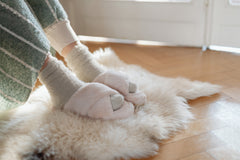Achilles Tendinitis 101

by Dr. Emily Splichal, DPM MS
“Heel pain” can be a vague term that is often associated with plantar fasciitis, however not all heel pain is on the bottom of the foot. Achilles tendinitis is a condition of the posterior or back of the heel, and is associated with pain, swelling and inflammation of the Achilles tendon or its insertion. More than 200,000 Americans are affected by Achilles tendinitis each year and it is most common in runners.
Achilles Tendon Anatomy
The Achilles tendon is the largest and strongest tendon in the human body. Running along the back of the ankle, this tendon connects your calf muscles to your heel bone and then actually blends into the plantar fascia under the foot.
Functionally, the Achilles tendon is used to transfer energy and create what’s called “plantarflexion torque” when we walk, run, climb stairs or jump. Although the Achilles tendon is designed to withstand great stresses from running and jumping, it is also prone to tendinitis, a condition associated with overuse and degeneration.
Types of Achilles Tendinitis
Like the plantar fascia, when demands exceed tissue tolerance, the Achilles tendon can begin to micro-tear, creating an inflammatory response within the tendon. This tendon inflammation is the body's natural response to injury or disease, and often causes swelling, pain, or irritation.
There are two types of Achilles tendinitis, based upon which part of the tendon is inflamed and injured.
Mid-Tendon Achilles Tendinitis

In mid-tendon or non-insertional Achilles tendinitis, fibers in the middle portion of the tendon have begun to break down with tiny tears, swelling and, often times, degeneration.
Often associated with decreased tendon elasticity and age, mid-tendon Achilles tendinitis often presents as pain during late mid-stance or when your heel is on the ground and you are about to take a step.
Insertional Achilles Tendinitis

Insertional Achilles tendinitis involves the lower portion of the heel, where the tendon attaches or inserts to the heel bone. Often associated with high arches, excess impact forces and limited ankle dorsiflexion, insertional Achilles tendinitis is typically more symptomatic at foot contact.
Symptoms of Achilles Tendinitis
Regardless of the type of Achilles tendinitis, the symptoms are similar to that of plantar fasciitis including:
- Pain and stiffness along the Achilles tendon, especially first step in the morning
- Pain along the tendon or back of the heel that worsens with activity
- Severe pain behind the heel the day after exercising
- Thickening of the tendon
- Bone spur (seen in insertional Achilles tendinitis)
- Swelling that is present all the time and gets worse throughout the day with activity
Treatment of Achilles Tendinitis
In most cases, conservative treatment options will provide sufficient pain relief for a majority of Achilles tendinitis. It is important to note, that due to the poor blood supply of the Achilles tendon, even with early treatment the recovery time is typically longer than plantar fasciitis, with 3 – 6 months as a typical recovery time frame.
Top conservative treatments include:
- Eccentric training (https://en.wikipedia.org/wiki/Eccentric_training)
- Myofascial release to calves and plantar foot
- NSAIDs or anti-inflammatory medications
- Rest, stopping all activities placing stress on the tendon
For those seeking alternative ways to support the body's natural healing function, an additional option is a supplement containing enzymes. Some enzymes, such as serrapeptase, bromelain and papain, have an immune-boosting benefit to help support the body’s inflammatory response. Studies have also shown that vitamin c rich foods, such as found in amla, can help your body produce the collagen that’s required to rebuild tissue after an injury. These ingredients have not been shown to have any serious long-term side effects.
If you are uncertain if you have Achilles tendinitis or have been treating your Achilles pain conservatively for several months and are not improving, I recommend seeing a Podiatrist to discuss additional treatment options.



Leave a comment